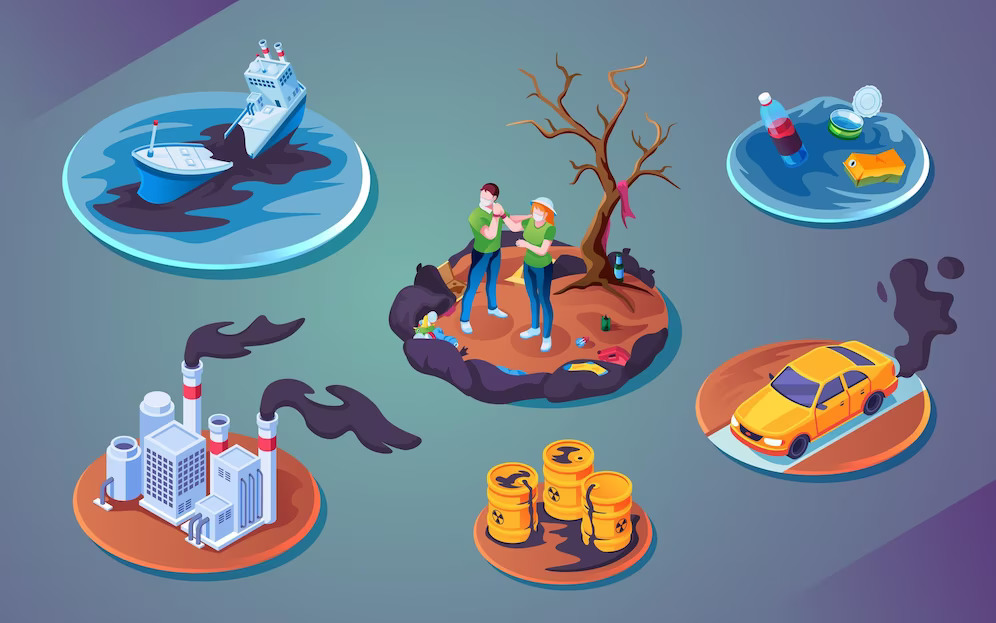Water is of fundamental importance when it comes to sustaining life on Earth. Having access to safe and clean drinking water is a basic human right. However, many communities around the world face the challenge of human-induced water drinking water contamination, which leads to serious health risks and environmental destruction.
Around the world, most water bodies in developed and developing nations are reportedly contaminated by industrial chemical discharge and agricultural runoffs. Continued research in this area has highlighted how high levels of contaminants in groundwater are the primary reason behind acute health effects.
Let’s discuss the varied types of water contaminants that pose one of the greatest risks to mankind.

What Are the Types of Water Contaminants?
Primarily, there are four types of contaminants that cause water pollution:
1. Organic Contaminants
These carbon-based pollutants originate from living organisms or human-made sources. They can enter water bodies through various means, including industrial discharges, agricultural runoff, and wastewater discharges. Organic contamination of groundwater can cause serious health problems like hormonal disruptions, cancers, and cognitive development disorders.
Some of the common pollutants of this kind include:
- Pesticides and Herbicides
Pesticides, when sprayed on crop plants, are able to flow below the surface of the ground, thereby contaminating groundwater. This results in groundwater pollution, making the drinking water unsuitable for both agricultural and human uses.
- Industrial Solvents
These include chemicals used in industrial processes, such as cleaning and degreasing. Some of the popular examples of such water pollutants include trichloroethylene (TCE), perchloroethylene (PCE), and benzene. As per TorHoerman Law, these compounds are generally found in metal degreasers, dry cleaning solvents, and other hazardous chemicals used in plastic production.
These chemicals belong to the category of volatile organic chemicals (VOCs) that can cause health effects like reproductive issues, birth defects, nervous system disorders, kidney and liver damage, and cancer.
In this regard, the Camp Lejeune lawsuit is the biggest water contamination case that the USA had to witness, where an estimated 1 million Marine Corps veterans and their families were exposed to high levels of VOC contaminants.
The contamination of drinking water at US Marine Corps base Camp Lejeune started in the early 1950s when industrial solvents such as trichloroethylene (TCE), perchloroethylene (PCE), and benzene seeped into the drinking water supply of the camp.
It is believed that water contamination at Camp Lejeune lasted approximately from 1953 to 1987. Marine veterans, their families, and workers who resided at the camp during this time period have been diagnosed with severe health issues, such as cancer, multiple myeloma, non-Hodgkin lymphoma, renal toxicity, reproductive issues, etc.
- Water Treatment Chemicals
Chemical compounds such as trihalomethanes, haloacetic acids, N-nitroso dimethyl amine, chlorine, etc., are carcinogenic in nature. A 2021 US carcinogen global report stated that haloacetic acids, byproducts in water treatment plants, are major carcinogenic compounds. Such chemicals have reportedly been the potential cause of colorectal and bladder cancer.
2. Inorganic Contaminants
These types of water pollutants are non-biodegradable compounds that result from industrial processes, mining, and agricultural activities. Examples of inorganic contaminants include arsenic, lead, fluoride, cadmium, mercury, aluminum, chromium, etc.
Exposure to inorganic pollutants through contaminated water can cause highly dangerous health issues. Many of these contaminants, such as mercury and lead, are neurotoxins. These have the ability to affect the cognitive function and development of the body, especially during early childhood.
Others, like arsenic, are carcinogenic. About 300 million people around the world are exposed to arsenic poisoning in groundwater. In the United States of America alone, more than 2.1 million people in 25 states are exposed to inorganic arsenic poisoning.
Arsenic poisoning can result in health issues such as cancer of bladder, skin, lungs, kidney, liver, and prostate. Additionally, mercury in water can cause neurological disorders, growth defects in children, reproductive issues, and disruption of the endocrine system. A high level of exposure to chromium can result in liver and kidney damage, dermatitis, and respiratory problems.
3. Radiological Contaminants
As the name suggests, these are radioactive elements that seep into the layers of groundwater to pollute sources of drinking water. Radium, Uranium, and Radon are the common radioactive materials that naturally percolate from the soil sediments to the aquifer, causing groundwater contamination.
Exposure to waterborne radiation can lead to the development of various disorders in humans, such as leukemia, genetic mutations, tuberculosis, osteonecrosis, and cataract initiation.
4. Biological Contaminants
Biological water contamination is caused by the growth of living organisms, such as bacteria, viruses, or algae, in drinking water. These organisms are capable of promoting the spread of various waterborne diseases such as dysentery, diarrhea, E. Coli, salmonellosis, and typhoid.
Viruses are the smallest single-celled living organisms that are capable of producing infection and causing diseases. Hepatitis and polio viruses are the commonly reported ones that are found in contaminated water. Additionally, various types of algae are capable of releasing toxins in the water that can damage the nervous system and cause skin diseases.
Biological contamination of water primarily happens when lakes, ponds, and streams used by communities get contaminated with animal and human feces or by wastewater released from sewage treatment plants.
Also Read: How Tech is Improving Electric Car Efficiency?
Wrapping Up
Preventing water contamination requires a combination of individual and collective efforts, as well as policy and regulatory measures. In addition to industries implementing effective waste treatment systems to reduce harmful discharges, responsible water use and pollution prevention should be encouraged at individual and community levels.
With stricter regulations on industrial pollutants in place, countries can prevent and protect their water bodies for current and future generations.


